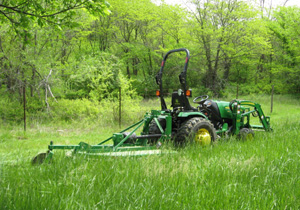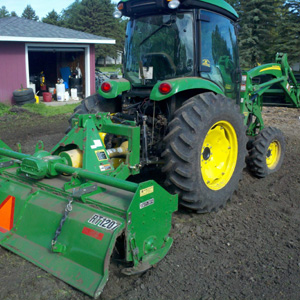Preparing Your Site
Removing Existing VegetationStart this process in the spring by mowing the current vegetation as short as possible. On small areas remove the debris and rototill the site. On larger areas where it is not practical to remove the debris, wait until the mowed vegetation is quite dry and then either plow or rototill the area depending on what equipment you are using.Preventing RegenerationAll plants need to experience the process of photosynthesis in order to live. By absorbing sunlight, plants turn that energy into food. In order to effectively kill the vegetation growing on your site you have to prevent the vegetation from experiencing photosynthesis. By denying these plants from the opportunity to create new food, the plants will use the energy they have stored in their roots and eventually, over the course of the growing season, this stored energy will be depleted and the plants will die. There are a few methods available for use to accomplish this. Here are some options:Options for Preparing an Existing Lawn SiteA) Smothering: On small lawn areas of 1000 square feet (92.9 m2) or less smothering weeds is simple, effective and requires no chemicals or special equipment. Smothering involves covering the lawn with black plastic, old rugs, 4x8 pieces of old plywood or a thick layer of leaves or newspapers. This should be left in place for a full growing season and removed in the fall when you are ready to plant.B) Sod Cutting: (For lawns free of perennial weeds only.) The quickest way to prepare a lawn for planting is to remove the top three inches (7.6 cm) of grass using a sod-cutter. This creates a nearly weed-free planting site ready for seeds. Be aware that the area will be lower than the surrounding lawn after sod removal. Sod cutters can be rented for this procedure. Once the sod is removed, rake the area with a steel rake to loosen the surface of the soil. C) Cultivation: Kill the lawn by cultivating with a rototiller three times at one-week intervals. Remove any clumps of sod and rake the area with a steel rake to create a smooth seed bed. If perennial weeds or rhizomatous perennial grasses such as Quackgrass or Johnsongrass are present in the lawn, cultivate for a full growing season every three weeks. This will kill both the lawn and the perennial weeds. After the lawn is dead, rake the area with a steel rake to loosen the surface of the soil. D) Herbiciding: If you choose to use herbicides we recommend using glyphosate (i.e. Roundup). When using herbicides READ THE LABEL and follow the manufacturer's instructions or hire a professional. When using herbicides, apply in fall or spring, when lawn grasses are actively growing. Cultivate after everything has turned brown to prepare the seedbed for planting (about two weeks after spraying). Please note that non-organic herbicides are now illegal in Alberta, Ontario, Quebec, and Maryland. Options for Preparing Newly Disturbed, or New Construction SitesAreas of bare soil resulting from recent construction may appear to be weed free at first but all soils contain an astonishing amount of weed seeds that will sprout, grow and may out-compete your wildflower seedlings. The best approach is to wait and see what comes up and then kill any weeds prior to installing your seed mix rather than seeding into a recently cleared/disturbed site.To prepare a new construction site or newly disturbed area, first allow the weeds to emerge and grow up to a height of six inches (15 cm). Once the area has sprouted and grown to reveal the existing weed bank, choose a preparation method from the options listed below. Options for Preparing Old FieldsOld fields that have been abandoned can be difficult to work up due to the presence of a variety of perennial weeds and grasses growing on the site. An old field usually requires at least a full year for proper site preparation. Completing two years of weed control is even better due to the presence of established perennial weeds and weed seeds in the soil. Please do not rush your site preparation if you are planting an old field. It cannot be over-emphasized that you need to eliminate all weeds before seeding. This may seem like a long time, but a little patience at this stage is essential for a successful planting.A) Organic Option: Mow and rake or burn off the existing vegetation to the ground in early spring. Cultivate to a depth of four inches (10 cm) every two to three weeks from spring through fall. Before planting, make sure all the existing weeds have been killed. This procedure may require two consecutive years of cultivating to kill pernicious, noxious weeds. When all the vegetation is dead, work the ground to prepare a seed bed. B) Non-Organic Option: Mow and rake or burn off the existing vegetation to the ground in early spring. Apply a glyphosate herbicide in late spring. Three weeks later cultivate the site to a depth of four inches (10 cm). In mid-summer spray with glyphosate again and three weeks later cultivate the site to a depth of four inches (10 cm). Repeat this one more time in early fall. In late fall when all the vegetation is dead, work the ground to prepare a seed bed. C) A Combination of Cultivation and Herbicides: In our experience, especially when dealing with old fields that have been infested with a wide variety of noxious perennial weeds, using a combination of cultivation and herbicides works best. Start by spraying the area with the herbicide after it has been mowed in the spring. Three weeks after spraying, cultivate the area. This cultivation will encourage weed seeds lurking in the soil to germinate. When this new "crop" of weeds is about an inch or two (2.5-5 cm) tall, typically about two to three weeks after this tilling, spray the site again with the herbicide. You'll need to repeat this tilling/spraying combination three more times throughout the season with the final application in late fall. Options for Preparing Corn, Soybean, and Grain FieldsCorn, Soybean and Grain fields that have been regularly sprayed with glyphosates typically have less weed problems compared to old fields and often require less preparation. These sites can easily be converted to a meadow. After the crop is harvested cultivate to a depth of four inches (10 cm) before planting. Plant in the late fall into a prepared seed bed. Before planting into corn fields, have the soil tested for persistent agrichemicals such as Atrazine. If Atrazine is present in your soil, we recommend allowing the site to sit for one to two years before you plant. If you are unsure of the site’s herbicide history, contact the farmer who owned the land before you as, by law, they must keep records of Atrazine use.Erosion Prone Sites:Precautions need to be taken on erosion prone sites. To avoid runoff and soil loss the site should not be left unvegetated for any length of time. Cultivation should be kept to a minimum. Preparing your site by cultivation only may create unwanted erosion problems. The site should be planted immediately following soil preparation.If you are unable to plant your seed immediately the site may be stabilized by planting annual rye grass at a rate of 50 lbs. (22.67 KG) per acre. Once the area has had a hard frost, mow it as short as possible, sow the seed mix into the stubble or spray with Roundup and no-till plant into the dead stubble. After planting, stabilize the slope by staking down straw erosion control blankets that are made up of two layers of a photodegradable plastic with straw placed in between the layers. Erosion control blankets have one half to one inch (.5 – 1 cm) openings which allows for unimpeded wildflower seedling development. Secure these blankets with landscape staples placed at one to two-foot (30 – 60 cm) intervals.
Preparing the Seed BedA) Preparing for Hand Broadcast Seeding: If you will be seeding a smaller area by hand broadcasting, till the soil very lightly, no more than one inch (2.5 cm) in depth. Rake well to smooth soil. Plant immediately. B) Preparing for Mechanical Seeding: Till or drag the soil very lightly, no more than one inch (2.5 cm) in depth. A field drag works very well for this job. Plant immediately. |


